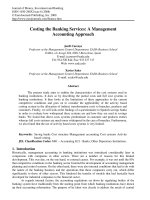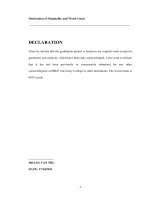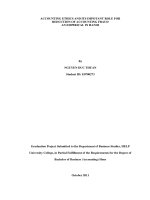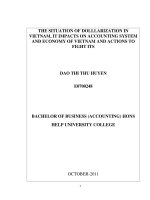Management Accounting: Costing and Budgeting (Assignment 2)
Bạn đang xem bản rút gọn của tài liệu. Xem và tải ngay bản đầy đủ của tài liệu tại đây (201.61 KB, 16 trang )
Unit 9: Management Accounting: Costing and Budgeting
Assignment 2:
Budgetary Planning
and Control
Prepared by Secret Gardent Group
MA Assignment
Lecturer: Mr. Jun AlejoBathan
Group: Secret Garden
TABLE OF CONTENT
INTRODUCTION...............................................................................................................3
Task1......................................................................................................................4
3.1 Explain the purpose and nature of the budgeting process.................................... 4
3.2 Select appropriate budgeting methods for the organization and its needs................. 5
3.3 Prepare budgets according to the chosen budgeting method.................................7
Task2 ....................................................................................................................10
3.4 Prepare a cash budget.......................................................................................10
Task3 ....................................................................................................................10
4.1 Calculate variances, identify possible causes and recommend corrective
action ...................................................................................................................10
4.2 Prepare an operating statement reconciling budgeted and actual results..............12
4.3Report findings to management in accordance with identified responsibility
centres................................................................................................................. 12
CONCLUSION....................................................................................................... 15
REFERENCES....................................................................................................... 16
2
MA Assignment
Lecturer: Mr. Jun AlejoBathan
Group: Secret Garden
INTRODUCTION
This asignment is about costing and budgeting. We are going to explain the purpose and
nature of the budgeting process, select appropriate budgeting methods for the
organization and its needs, prepare budgets according to the chosen budgeting method,
calculate variances, identify possible causes and recommend corrective action, prepare
an operating statement reconciling budgeted and actual results, rexport findings to
management in accordance with identified responsibility centres.
3
MA Assignment
Lecturer: Mr. Jun AlejoBathan
Group: Secret Garden
Task1
3.1 Explain the purpose and nature of the budgeting process
a. Purposes of the budgeting process
There are seven purposes of the budgeting process (BPP, 2012):
• To ensure the achievement of the organization's objectives: Using the
budget, the manager can see how far that they have reached on their targets
plan in the timescale and make the further detail strategy for the company (John
Freedman, 2012).
• To compel planning: Budgeting process not only forces management look
ahead to set out the plan for the future,what resources are available and what
additional resources will be needed, but also helps them see the problem of the
company (John Freedman, 2012).
• To communicate ideas and plans: Managers can use budgeting as the tool for
communicate between them and their subordinates, to show them the effect of
he or she on the process of company.In the budgeting process, managers in
every department justify the resourcesthey need to achieve their goals. They
explain to their superiors the scope and volume of their activities as well as how
their tasks will be performed (John Freedman, 2012).
• Co-ordinate activities: Different units in the company must also coordinate the
many different tasks they perform. For example, the number and types of
products to be marketed must be coordinated with the purchasing and
manufacturing departments to ensure goods are available. Equipment may have
to be purchased and installed. Advertising promotions may need to be planned
and implemented. And all tasks have to be performed at the appropriate times
(John Freedman, 2012).
• To provide a framework for responsibility accounting: Budgeting ensures
that who makes the budgets must have responsibility for what they summit. The
reason for that is the budget affect the operation of company and can cause
profit or lost (John Freedman, 2012).
• To establish a system of control: Once a budget is finalized, it is the plan for
the operations of the organization. Managers have authority to spend within the
budget and responsibility to achieve revenues specified within the budget (John
Freedman, 2012).
4
MA Assignment
Lecturer: Mr. Jun AlejoBathan
Group: Secret Garden
• Motivate employees to improve their performance: Budgets can be used to
motivate your staff to be more fiscally minded, to pay greater attention to detail
and to think before they act (John Freedman, 2012).
b. Nature of budgeting process
The budgeting process involves:
• Setting up budget, it means planning targets of revenue, expenses, assets and
liabilities relating to the activities concerned
• Measuring actual results against the budgets on a continuous basis
• Identifying and analyzing divergences from budgets, and modifying both actual
operations and subsequent budgets (Finntrack, 2012).
3.2 Select appropriate budgeting methods for the organization and its needs.
a. Fixed and flexible method
• Fixed budget
Advantage:
- Allowing a business to measure both short-term and long-term budgets.
- Allocating a set amount of money towards essentials such as overhead costs.
- Making profit measurement easier, since you allocate the same amount of
money towards necessities on a regular basis. (Montoya, 2012)
Disadvantage:
- Not accounting for inflation and rise in costs, so fixed budget will not go as far
as the previous years
- Do not have any flexibility to deal with change in the environment
•
(emergencies, personnel, competitive, pressure) (wiseGEEK, 2003)
Flexible budget
Advantage
- At the planning stage, it may be helpful to know what the effects would be if
the actual outcome differs from the prediction
- At the end of each month of year, actual may be compared with the relevant
activity level in the flexible budget as a control procedure (Mclntosh, 2001)
Disadvantage
- By not allowing the manager to insert set figures, prediction is difficult.
- When one variable in a flexible budget is subject to changes, other variables
in the budget can also change, too.
- Making the estimate of an organization’s tax burden tough
- More complicated and taking longer to prepare than a static budget (eHow,
2012)
b. Incremental and zero based budgeting system
• Incremental budgeting
Advantage
- The budget operates under a stable and predictable system and any change
will be gradual.
5
MA Assignment
Lecturer: Mr. Jun AlejoBathan
Group: Secret Garden
- The impact of change can be seen quickly.
- Managers can operate their departments on a consistent basis.
- The system is simple to operate and easy to understand.
- Conflicts should be avoided if departments can be seen to be treated (tutor2u,
2012).
Disadvantage
- No incentive for developing new ideas.
- No incentives to reduce costs.
- Encourages spending up to the budget so that the budget is maintained next
year.
- The budget may become out of date and no longer relate to the level of
activity or type of work being carried out (tutor2u, 2012).
• Zero based budgeting
Advantage
- Allocation of resources linked to results and needs.
- Develops a questioning attitude.
- Wastage and budget slack should be eliminated.
- Prevents creeping budgets based on previous year’s figures with an added on
percentage.
- Encourages managers to look for alternatives (tutor2u, 2012).
Disadvantage
- It a complex time consuming process
- Short term benefits may be emphasized to the detriment of long term
planning
- Affected by internal politics - can result in annual conflicts over budget
allocation (tutor2u, 2012).
c.Top down budgeting
Advantage
- Allowing upper managers to maintain complete financial control over a budget
(financial control)
- Greater financial accountability and more comparison-shopping for products,
services and consulting help (accountability of staff)
- Less time intensive, as it includes only the input of key decision- markers
(faster process) (eHow, 2012)
Disadvantage
- Creating a budget without the input of key personnel from the rank and file
can result in underfunding or overfunding of a department (inaccurate
forecasting)
- Avoiding the risk of getting less money the following year (potential for
underperformance)
6
MA Assignment
Lecturer: Mr. Jun AlejoBathan
Group: Secret Garden
- Managers and employees may be resentful that their input is not valued in the
budgeting process (employee morale) (eHow, 2012)
d.Conclusion
Budgeting method will helps Cabot Company for setting budgets and preparing
it in the future. To make budgetary become more accurately, through top- down
method, Cabot company will tend to estimate budgeted sales that is more
reliable than sales budget which is set by top- management. Production budget
setting by senior- management is less accurately than estimate budget for
production based on production capacity and expected sales. Besides, lowerlevel management can take part in budgeting process. On the other hand, zero
based budgeting, incremental budgeting, fixed budget, flexible budget also have
some limits for the company when preparing budget.
3.3 Prepare budgets according to the chosen budgeting method
•
Sales budget
Cabot Co.
Sales Budget
For July of 2006
Products
K
L
40,000
20,000
Expected unit
sales
X £30
X £65
Unit selling price
£1,200,000 £1,300,000
Total sales
£2,500,000
Figure 1: Cabot Co. Sales Budget for July of 2006
As it can see that we got the total sales of 2 products K and L are £1,200,000 and
£1,300,000 respectively. Therefore, sales budget of this company is £2,500,000
•
Production budget
Cabot Co.
Production Budget
For July of 2006
Products
(units)
K
L
40,000
20,000
Expected unit sales
2,500
2,000
Add: Desired
inventories
42,500
22,000
Total required units
7
MA Assignment
Lecturer: Mr. Jun AlejoBathan
Less: Estimated
inventories
Required product units
Group: Secret Garden
3,000
2,700
£39,500 £19,300
£58,800
Figure 2: Cabot Co. Production Budget
for July of 2006
According to the above table, required product units of product K is £39,500 while
required product units of product L is £19,300. So the total required product units of
both products are £58,800.
•
Direct materials purchases budget
Cabot Co.
Direct materials purchases Budget
For July of 2006
Material
A
B
27,650
47,400
Product K (lbs)
67,550
34,740
Product L (lbs)
95,200
82,140
Units to be produced
(lbs)
3,000
2,500
Add: Desired
inventories (lbs)
4,000
3,500
Less: Estimated
inventories (lbs)
94,200
81,140
Direct material
purchase (lbs)
x £4
x £2
Cost per lb
£376,800 £162,280
Total cost of direct
materials purchases
£539,080
Figure 3: Cabot Co. Direct materials purchases Budget
for July of 2006
It can be seen that total cost of direct material A purchases £376,800 whereas total
cost of direct material B purchases £162,280. As a result, total cost of both direct
material purchases £539,080.
•
Direct labor purchases budget
Cabot Co.
Direct labor purchases Budget
For July of 2006
Department
8
MA Assignment
Lecturer: Mr. Jun AlejoBathan
Group: Secret Garden
1
15,800
11,580
27,380
Product K (hrs)
Product L (hrs)
Hours to be produced
(hrs)
Direct labor rate
Total direct labor cost
2
5,925
4,825
10,750
x £12
x £16
£328,560 £172,000
£500,560
Figure 4: Cabot Co. Direct labor purchases Budget
for July of 2006
Based on information from the table, total direct labor cost of two departments are
£328,560 and £172,000. After calculating, the total direct labor cost of both
departments is £500,560.
•
Cost of goods sold budget
Cabot Co.
Cost of goods sold Budget
For July of 2006
£
539,080
500,560
299,000
Direct materials cost
Direct labor cost
Estimated factory overhead
cost
Total receipts
Add: Estimated inventories
1,338,640
145,500
Less: Desired inventories
Total cost of goods sold
112,500
1,371,640
Figure 5: Cabot Co. Cost of goods sold Budget
for July of 2006
From information gathering, the total cost of goods sold of Cabot Company is
accounted £1,371,640.
Task2 (3.4 Prepare a cash budget)
Month
Receipt
11/11
12/11
1/12
9
2/12
3/12
4/12
MA Assignment
Lecturer: Mr. Jun AlejoBathan
Group: Secret Garden
from sales
Sales
70%
received
28%receive
d
Total
receipt
from sales
Payments
Payment for
purchasing
with the old
method
Payment for
purchasing
with the
new
method
Total
payments
with the
old method
Total
payments
with the
new
method
Overhead
Cost of
sales 60%
Stock at the
end of
month
Increase of
stock
Purchase
Net cash
inflow with
the old
method
Net cash
inflow with
the new
method
Difference
between 2
methods
110,00
0
66,00
0
115,00
0
77,00
0
120,000
80,50
0
30,80
0
130,000
84,00
0
32,20
0
140,000
130,000
91,000
98,000
33,600
36,400
111,300
116,200
124,600
134,400
67,320
75,240
83,160
85,140
67,320
37,620
79,580
84,570
96,320
104,240
112,160
114,140
66,620
29,000
78,00
0
108,580
29,000
113,570
29,000
69,00
0
96,320
29,000
72,00
0
84,000
78,000
58,000
62,000
68,000
70,000
73,000
6,000
2,000
3,000
68,000
4,000
76,00
0
84,000
86,000
81,000
14,980
11,960
12,440
20,260
14,980
49,580
16,020
20,830
37,620
3,580
570
10
MA Assignment
Lecturer: Mr. Jun AlejoBathan
Group: Secret Garden
In our opinion, the company should use the new method. We can see the different
between two methods according to the result of above table, net cash inflow with the new
method is higher than net cash inflow with the old method. It caused of total payment for
purchases calculating with new method is lower than the total payment wich be calculated
with old method.
Task3
4.1 Calculate variances, identify possible causes and recommend corrective action
Variance analysis
1.Sales price variance
Standard selling price - standard cost = £130-£76
Actual selling price - standard cost = £136-£76
Sales price variance per unit
Sales price variance in £ (x 190 units)
£
54
60
6 (F)
1,140 (F)
Recommend: The company should sell products with high quality to be able to raise selling
price, or produce more units.
2.Sales volume variance
Standard sales volume
Actual sales volume
Sales volume profit variance in units
x standard profit per unit
Sales volume variance in £
200 units
190 units
10 units (A)
£54
£540 (A)
Recommend: The company should produce and sell more products; at least it should be
higher than 200 units.
3. Material price variance
£
230 units at £10 should cost
2,300
but was (x £11)
2,530
Material price variance
230 (A)
Recommend: The company can choose the source, the supplier to buy material which is
appropriate with their demand and lower than standard material price.
4. Direct labor cost variance
£
230 units at £12 should cost
2,760
but was (x £10)
2,300
Direct labor cost variance
460 (F)
Recommend: The company can choose quality of labor that they recruit to lower the labor
cost.
5. Variable cost overhead
£
230 units of variable cost overhead at £4
920
but was (x £5)
1,150
Variable cost overhead
230 (A)
11
MA Assignment
Lecturer: Mr. Jun AlejoBathan
Group: Secret Garden
Recommend: The company should manage well all their equipments and maintain on time.
6.Fixed product overhead expenditure
£
Standard fixed overhead 220 units at £50
11,000
Actual fixed overhead 230 units at £52
11,960
Fixed product overhead expenditure
960 (A)
Recommend: The company be tight with fixed product overhead like water, electricity, oil,
that they use when producing.
7.Fixed overhead volume variance
Standard production volume
Actual production volume
Fixed overhead volume variance in unit
Standard fixed overhead
Fixed overhead volume variance in £
220 units
230 units
10 units (F)
50
£500 (F)
Recommend: The company should produce more units to keep the variance favorable
8.Fixed administration, selling and distribution expenditure
Standard fixed administration, selling and distribution overhead
Actual fixed administration, selling and distribution overhead
Fixed administration, selling and distribution expenditure
£
8,800
8,650
150 (F)
Recommend: The company should adjust selling and distribution expenditure, such as,
repairs and maintenance and insurance of delivery vans, transit insurance of finished
goods, advertisement, to make it appropriate and more effective.
4.2 Prepare an operating statement reconciling budgeted and actual results
Sales
Units sell
Unit price
Cost
- cost of goods sold
+ cost production
Unit standard cost of production
Materials
Direct labor
Variable overheads
Fixed overhead
Unit actual cost of production
Material
Direct labor
Variable overheads
Fixed overhead
Unit produced
Standard (£)
26,000
200
130
24,000
15,200
16,720
76
10
12
4
50
220
12
Actual (£)
25,840
190
136
23,550
14,900
17,940
78
11
10
5
52
230
MA Assignment
Lecturer: Mr. Jun AlejoBathan
+ less stock
- Administration overheads
Profit
Profit variance
Group: Secret Garden
1,520
8,800
2,000
3,040
8,650
2,290
290
The operating statement reconciling budgeted and actual results comes from the
calculation of variance. According to the statement that we get, it can be seen that profit
variance of actual is higher than standard. Therefore, it shows that the activity of this
company is quite good.
4.3Report findings to management in accordance with identified responsibility
centres
According to eight variances that we already calculated, it can be seen that Lowther
Limited just use Cost Centre and Revenue Centre.
•
Cost Centre has responsibility for sales price variance and sales volume variance
− Sales price variance: It is a favorable variance because the actual sales are
higher than standard sales. The company should sell products with high quality
to be able to raise selling price. Furthermore they can reduce expenditures
such as newspaper everyday for offices.
− Sale volume variance: the actual sales volume is lower than the standard sales
volume, so it is adverse variance. In this case, the company should produce
•
and sell more products; at least it should be higher than 200 units.
Revenue Centre has responsibility for material price variance, direct labor cost
variance, variable cost overhead, fixed product overhead expenditure, fixed overhead
volume variance, and fixed administration, selling and distribution expenditure.
− Material price variance: It is an adverse variance because the price of material in
actual process is higher than they expect. It can be influenced by material’s price on
market, so the company cannot control. However they can choose the source, the
supplier to buy material which is appropriate with their demand and lower than
standard material price.
− Direct labor cost variance: The actual labor cost is lower than standard labor cost; it
means the variance is favorable. Same as material price, labor cost based on market
price and labor rate as well. The company can choose quality of labor that they recruit
to lower the labor cost.
− Variable cost overhead: it is adverse variance, because actual variable cost overhead
is higher than standard variable cost over head. It can be caused of cost of repair
machinery irregular. The solution for this is the company should manage well all their
equipments and maintain on time.
− Fixed product overhead expenditure: Actual fixed overhead is higher than standard,
the actual units were sold is higher than standard ones also, therefore, fixed product
overhead expenditure is adverse. In order to make it favorable, Lowther Limited should
13
MA Assignment
Lecturer: Mr. Jun AlejoBathan
Group: Secret Garden
be tight with fixed product overhead like water, electricity, oil, that they use when
producing.
− Fixed overhead volume variance: the difference between actual and standard fixed
overhead volume variance is from the production volume. Actual production volume of
production achieved was greater than the standard, so it is favorable. It shows that the
company produces the goods very well so they make the actual production volume
higher. They need to keep it up, producing more units.
− Fixed administration, selling and distribution expenditure: the actual expenditure
spends on administration, selling and distribution is lower than the standard ones, so it
is favorable. The salary pay for administration staff is always fixed; it means the
company can adjust selling and distribution expenditure, such as, repairs and
maintenance and insurance of delivery vans, transit insurance of finished
goods, advertisement, to make it appropriate and more effective.
14
MA Assignment
Lecturer: Mr. Jun AlejoBathan
Group: Secret Garden
CONCLUSION
Ater all of our calculation, explain, and recomendation for two companies above, we can
see that all companies have their own problems and different solutions to solve them
based on the situation of the company. We need to stand at the point of manager to think
and decide which way to choose to make the business better and company is stronger.
15
MA Assignment
Lecturer: Mr. Jun AlejoBathan
Group: Secret Garden
REFERENCES
eHow (2005) The Disadvantages of a Flexible Budget. [online] Available at:
[Accessed: 20
Dec 2012].
eHow (2012) The Advantages and Disadvantages of Top-Down Budgeting. [online]
Available at: [Accessed: 20 Dec 2012].
Small Business - Chron.com (2012) The Advantages of Using a Fixed Budget. [online]
Available at: [Accessed: 20 Dec 2012].
Mcintosh, K. (2001) The Advantages of a Flexible Budget. [online] Available at:
[Accessed: 20
Dec 2012].
wiseGEEK (2003) What Are the Pros and Cons of a Fixed Budget?. [online] Available
at: />[Accessed: 20 Dec 2012].
Small Business - Chron.com (2011) How Is a Budget Used to Motivate a Staff?. [online]
Available at: />[Accessed: 20 December 2012].
16









